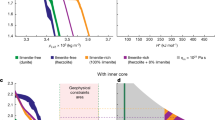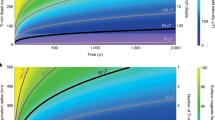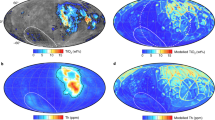Abstract
Although the Moon currently has no internally generated magnetic field, palaeomagnetic data, combined with radiometric ages of Apollo samples, provide evidence for such a magnetic field from ∼3.9 to 3.6 billion years (Gyr) ago1, possibly owing to an ancient lunar dynamo1,2. But the presence of a lunar dynamo during this time period is difficult to explain1,2,3,4, because thermal evolution models for the Moon5 yield insufficient core heat flux to power a dynamo after ∼4.2 Gyr ago. Here we show that a transient increase in core heat flux after an overturn of an initially stratified lunar mantle might explain the existence and timing of an early lunar dynamo. Using a three-dimensional spherical convection model6, we show that a dense layer, enriched in radioactive elements (a ‘thermal blanket’), at the base of the lunar mantle can initially prevent core cooling, thereby inhibiting core convection and magnetic field generation. Subsequent radioactive heating progressively increases the buoyancy of the thermal blanket, ultimately causing it to rise back into the mantle. The removal of the thermal blanket, proposed to explain the eruption of thorium- and titanium-rich lunar mare basalts7, plausibly results in a core heat flux sufficient to power a short-lived lunar dynamo.
This is a preview of subscription content, access via your institution
Access options
Subscribe to this journal
Receive 51 print issues and online access
$199.00 per year
only $3.90 per issue
Buy this article
- Purchase on Springer Link
- Instant access to full article PDF
Prices may be subject to local taxes which are calculated during checkout

Similar content being viewed by others
References
Cisowski, S. M., Collinson, D. W., Runcorn, S. K. & Stephenson, A. A review of lunar paleointensity data and implications for the origin of lunar magnetism. J. Geophys. Res. 88, A691–A704 (1983)
Collinson, D. W. Magnetism of the Moon—A lunar core dynamo or impact magnetization? Surv. Geophys. 14, 89–118 (1993)
Stevenson, D. J. Planetary magnetic fields. Rep. Prog. Phys. 46, 555–620 (1983)
Runcorn, S. K. The formation of the lunar core. Geochim. Cosmochim. Acta 60, 1205–1208 (1996)
Konrad, W. & Spohn, T. Thermal history of the Moon: Implications for an early core dynamo and post-accretional magmatism. Adv. Space Res. 19, 1511–1521 (1997)
Baumgardner, J. R. Three dimensional treatment of convective flow in the Earth's mantle. J. Stat. Phys. 39, 501–511 (1985)
Hess, P. C. & Parmentier, E. M. A model for the thermal and chemical evolution of the Moon's interior: Implications for the onset of mare volcanism. Earth Planet. Sci. Lett. 134, 501–514 (1995)
Warren, P. H. The magma ocean concept and lunar evolution. Annu. Rev. Earth Planet. Sci. 13, 201–240 (1985)
Jellinek, A. M., Kerr, R. C. & Griffiths, R. W. Mixing and compositional stratification produced by natural convection. 1. Experiments and their application to Earth's core and mantle. J. Geophys. Res. 104, 7183–7202 (1999)
Zhong, S., Parmentier, E. M. & Zuber, M. T. A dynamic origin for the global asymmetry of lunar mare basalts. Earth Planet. Sci. Lett. 177, 131–140 (2000)
Wieczorek, M. A. & Phillips, R. J. The ‘Procellarum KREEP Terrane’: Implications for mare volcanism and lunar evolution. J. Geophys. Res. 105, 20417–20430 (2000)
Stevenson, D. J., Spohn, T. & Schubert, G. Magnetism and thermal evolution of the terrestrial planets. Icarus 54, 466–489 (1983)
Stacey, F. D. & Loper, D. E. Thermal histories of the core and mantle. Phys. Earth Planet. Inter. 36, 99–115 (1984)
Buffett, B. A., Huppert, H. E., Lister, J. R. & Woods, A. W. On the thermal evolution of the Earth's core. J. Geophys. Res. 101, 7989–8006 (1996)
Stevenson, D. J. Mars' core and magnetism. Nature 412, 214–219 (2001)
Roberts, P. H. & Soward, A. M. Dynamo theory. Annu. Rev. Fluid Mech. 24, 459–512 (1992)
Williams, J. G., Boggs, D. H., Yoder, C. F. & Ratcliff, J. T. Lunar rotational dissipation in solid body and molten core. J. Geophys. Res. 106, 27933–27968 (2001)
Bunge, H.-P. & Baumgardner, J. R. Mantle convection modeling on parallel virtual machines. Comput. Phys. 9, 207–215 (1995)
Yang, W.-S. & Baumgardner, J. R. A matrix-dependent transfer multigrid method for strongly variable viscosity infinite Prandtl number thermal convection. Geophys. Astrophys. Fluid 92, 151–195 (2000)
Christensen, U. R. Heat transport by variable viscosity convection and implications for the Earth's thermal evolution. Phys. Earth Planet. Inter. 35, 264–282 (1984)
Moresi, L.-N. & Solomatov, V. S. Numerical investigation of 2D convection with extremely large viscosity variations. Phys. Fluids 7, 2154–2162 (1995)
Jellinek, A. M., Lenardic, A. & Manga, M. The influence of interior mantle temperature on the structure of plumes: Heads for Venus, tails for Earth. Geophys. Res. Lett. 29, doi:10.1029/2001GL014624 (2002)
Davaille, A. Simultaneous generation of hotspots and superswells by convection in a heterogeneous planetary mantle. Nature 402, 756–760 (1999)
Gonnermann, H. M., Manga, M. & Jellinek, A. M. Dynamics and longevity of an initially stratified mantle. Geophys. Res. Lett. 29, doi:10.1029/2002GL01485 (2002)
Hood, L. L., Mitchell, D. L., Lin, R. P., Acuna, M. H. & Binder, A. B. Initial measurements of the lunar induced magnetic dipole moment using Lunar Prospector magnetometer data. Geophys. Res. Lett. 26, 2327–2330 (1999)
Jolliff, B. L., Gillis, J. J., Haskin, L. A., Korotev, R. L. & Wieczorek, M. A. Major lunar crustal terranes: Surface expressions and crust–mantle origins. J. Geophys. Res. 105, 4197–4216 (2000)
Haskin, L. A., Gillis, J. J., Korotev, R. L. & Jolliff, B. L. The materials of the lunar Procellarum KREEP Terrane: A synthesis of data from geomorphological mapping, remote sensing, and sample analyses. J. Geophys. Res. 105, 20403–20415 (2000)
Delano, J. Pristine lunar glasses: Criteria, data and implications. J. Geophys. Res. 91, 201–213 (1986)
Hess, P. C. On the source regions for mare picrite glasses. J. Geophys. Res. 105, 4347–4360 (2000)
Anderson, O. L. The Gruneisen parameter for iron at outer core conditions and the resulting conductive heat and power in the core. Phys. Earth Planet. Inter. 109, 179–197 (1998)
Stacey, F. D. & Anderson, O. L. Electrical and thermal conductivities of Fe-Ni-Si alloy under core conditions. Phys. Earth Planet. Inter. 124, 153–162 (2001)
Stegman, D. R., Richards, M. A. & Baumgardner, J. R. Effects of depth dependent viscosity and plate motions on maintaining a relatively uniform MORB reservoir in whole mantle flow. J. Geophys. Res. 107, doi:10.1029/2001JB000192 (2002)
Tackley, P. J. Effects of strongly variable viscosity on 3-dimensional mantle convection. J. Geophys. Res. 101, 3311–3332 (1996)
Acknowledgements
We thank B. Buffett for helpful discussions; C. Johnson, R. Jeanloz, M. Manga and H.-P. Bunge for comments; and D. Stevenson and M. Zuber for reviews that improved this manuscript. We dedicate this work to the memory of our co-author Stephen Zatman, who inspired us by his interest in this subject. This work was supported by IGPP LANL, NASA CT project, the National Science Foundation, and the Miller Institute for Basic Research in Science.
Author information
Authors and Affiliations
Corresponding author
Ethics declarations
Competing interests
The authors declare that they have no competing financial interests.
Rights and permissions
About this article
Cite this article
Stegman, D., Jellinek, A., Zatman, S. et al. An early lunar core dynamo driven by thermochemical mantle convection. Nature 421, 143–146 (2003). https://doi.org/10.1038/nature01267
Received:
Accepted:
Issue Date:
DOI: https://doi.org/10.1038/nature01267
This article is cited by
-
A lunar time scale from the perspective of the Moon’s dynamic evolution
Science China Earth Sciences (2024)
-
Effects of magma-generation and migration on the expansion and contraction history of the Moon
Earth, Planets and Space (2022)
-
An episodic high-intensity lunar core dynamo
Nature Astronomy (2022)
-
Thermal conductivity of iron and nickel during melting: Implication to the planetary liquid outer core
Pramana (2022)
-
Thermodynamic properties of geikielite (MgTiO3) and ilmenite (FeTiO3) derived from vibrational methods combined with Raman and infrared spectroscopic data
Physics and Chemistry of Minerals (2022)
Comments
By submitting a comment you agree to abide by our Terms and Community Guidelines. If you find something abusive or that does not comply with our terms or guidelines please flag it as inappropriate.



